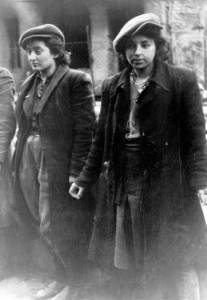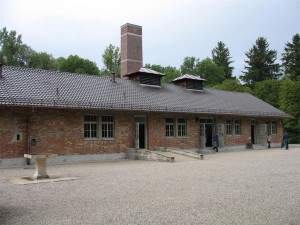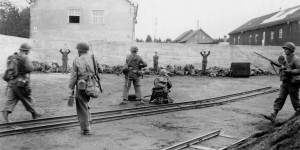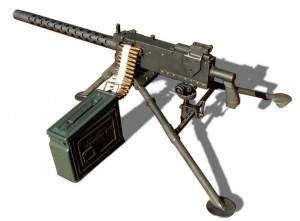My visit to a Nazi death camp
January 27, 2024 by Thomas Wictor
On January 27, 1945, the 322nd Rifle Division of the Soviet Army liberated Auschwitz, a gulag of forty-eight Nazi extermination camps in southern Poland. In 2005 the United Nations designated January 27 International Holocaust Remembrance Day. The Israelis don’t commemorate the Holocaust on January 27. Instead, they have Yom HaShoah on the 27th day of the Israeli month of Nisan, April or May of the Gregorian calendar. This year Yom HaShoah is April 15.
Yom HaShoah takes place near the anniversary of the Warsaw Ghetto Uprising (April 19, 2024 to May 16, 2023). After the Nazi invasion of Poland on September 1, 1939, the Germans began putting Jews in ghettos. The largest was in Warsaw, where around 380,000 were squeezed into an area of 1.3 square miles (3.3 square kilometers). Though the Jews initially didn’t fight—believing that those deported from the ghetto were merely sent to work camps—they eventually learned that their destination was to be Treblinka death camp, where approximately 300,000 of the ghetto’s residents were murdered.
The Jews began armed resistance in January of 1943. In response, the Nazis entered the ghetto in force on April 19, where they were met by around 1000 men and women of the Jewish Combat Organization (Żydowska Organizacja Bojowa or ŻOB), the Jewish Military Union (Żydowski Związek Wojskowy or ŻZW), the He-halutz Zionist youth organization, the Home Army (Armia Krajowa or AK) and the People’s Guard (Gwardia Ludow or GL). The Jews were armed mostly with handguns, grenades, and Molotov cocktails. A few non-Jewish Polish resistance fighters—such as Henryk Iwański—entered the ghetto to help; they had access to rifles and light machine guns.
Although the Germans were heavily armed with machine guns, trench mortars, antiaircraft cannons used horizontally, and armored cars, the Jewish and non-Jewish Poles fought with such ferocity from the buildings and sewers that after several assaults the Nazis were forced to clear the ghetto house by house with dynamite, flamethrowers, and gasoline bombs. The fighting ended on May 16, 1943, when SS Brigadeführer Jürgen Stroop personally blew up the Great Synagogue of Warsaw.
Stroop is the much-decorated soldier third from the left, the one whose face is not obscured by the raised machine pistol.
He exaggerated the danger he and his men faced. For example, he captioned this photo “Forcibly pulled from dugouts.”
That’s a building, not a dugout, and those are unarmed women and children emerging voluntarily.
About 13,000 Jews were killed, and most of the surviving 50,000 were transported to extermination camps.
An excerpt from Stroop’s report for May 16, 1943.
180 Jews, bandits and sub-humans, were destroyed. The former Jewish quarter of Warsaw is no longer in existence. The large-scale action was terminated at 20:15 hours by blowing up the Warsaw Synagogue… Total number of Jews dealt with 56,065, including both Jews caught and Jews whose extermination can be proved… Apart from 8 buildings (police barracks, hospital, and accommodations for housing working-parties) the former Ghetto is completely destroyed. Only the dividing walls are left standing where no explosions were carried out.
After the war Stroop was convicted of murdering nine American prisoners. He was then extradited to Poland, where he was convicted of crimes against humanity and hanged on March 6, 1952.
There were miracles in the Warsaw Ghetto Uprising. Jewish fighter Malka Zdrojewicz is seen on the right after her capture by Stroop’s men.
Sent to Majdanek death camp, Zdrojewicz survived and emigrated to present-day Israel in 1946. She married and had four children.
In 1993 I saw the film Schindler’s List and was very impressed with it—except for the final scenes. They came across as schmaltzy to me, though I’ll be the first to admit that I’m a very nitpicking movie watcher.
I recently watched Schindler’s List for the first time in over twenty years, and this time I didn’t like the entire film. It seemed manipulative and somehow cynical. What I mean is that the performances were too preciously self-conscious. Watch the French film A Very Long Engagement, the best war movie ever made, and you’ll see what I mean. Maybe my parents’ deaths made me into a pathological nitpicker when it comes to the cinematic depiction of lives ending. I don’t know. This time the Schindler’s List really rubbed me the wrong way.
On this International Holocaust Remembrance Day, I’d like to describe my experience visiting Dachau death camp in the summer of 1980. I’d just graduated from high school and was on my way to Greece by train. My four “friends” and I had an immediate falling out because all they wanted to do was get drunk. I was interested in seeing the countries through which we passed. Therefore in Bavaria, while the others scampered off to watch X-rated movies, I went to Dachau.
It was utterly haunted. Two other locations have had the same effect on me: Hiroshima and Gettysburg. At places where mass killing and suffering occur, the ground itself becomes charged with negative energy. Dachau was far worse than Hiroshima and Gettysburg, however. It was evil almost beyond my ability to stand it. I’ve never felt such visceral horror. It nauseated me.
I forced myself to stay because I owed it to the people who’d been murdered there. It was a form of bearing witness. By the crematorium, I was overcome by a strange but specific urge.
I knelt and dug in the earth somewhere off to the right, using my fingers. About six inches down, I found bone fragments. There’s no question. Bone is very light—like wood—but much harder. I reburied the fragments and said a prayer for all of the Nazis’ victims.
People tell me that Jews “make too much” of the Holocaust. I don’t know what that means. My guess is that none of these complainers have visited a Nazi death camp.
There are many photos of Nazi guards killed by the inmates of Dachau after the Americans liberated the camp. Americans killed some of the guards as well.
Wikipedia claims that this image shows American soldiers shooting SS guards, but it obviously doesn’t.
There are no bullet holes in the walls, and none of the standing Nazis look afraid. The two soldiers in the center are covering the guards with a Browning .30 caliber air-cooled machine gun.
You can see the tripod and an ammunition box, but there’s no cartridge belt visible. What happened is that the Americans screamed at the Nazis to lie down; most of them are groveling in the dirt where they belong. Nobody’s been shot.
I can’t imagine being one of the Americans who’d seen with his own eyes what the Nazis had done there. The Nazis used human beings in obscene “medical experiments” that were actually just exercises in sadism. So if a handful of the guards were killed, I have no problem with that.
You see, I was there. I felt all the agony, and I dug up the bones.
Go to a Nazi death camp before you lecture Jewish people on how they should react to the Holocaust. My guess is if you take me up on my suggestion, you’ll be keeping your trap shut from then on.
This article viewed 687 times.







